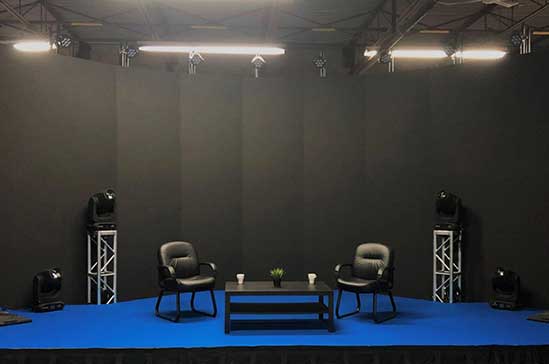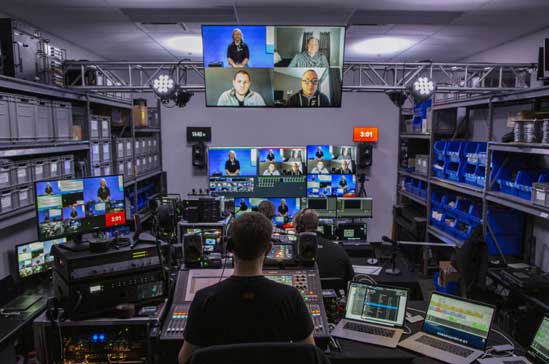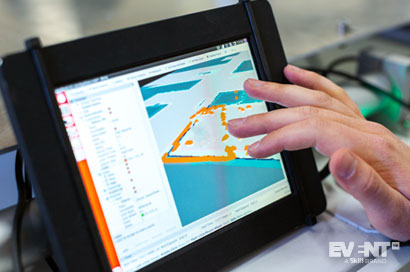Skift Take
AV companies are joining the ranks of event tech suppliers supporting the pivot to virtual with studio and production venues that enhance virtual engagement through higher production value and consulting support.
Virtual events have finally gained a strong foothold within the events industry as one positive byproduct of restrictions on travel and physical gatherings, with major event brands pivoting to virtual. But where virtual event tech companies are struggling to keep up with the demand, event audiovisual (AV) companies have just been struggling.
At the same time, when it comes to creating a level of engagement on par with what we have come to expect from well established video streaming services, the current offerings often leave planners in the lurch.
That’s where virtual venues and live event production studios come in. Various AV and event tech companies have begun to introduce these types of ‘venues’ as a solution for planners who recognize the need for high-quality environments that keep people engaged.
These companies provide services and support to fully-online — and eventually hybrid — events that require reliable, high-quality content.
So what exactly are virtual venues and what value do they add to virtual and hybrid events moving forward?
A New Kind of Venue
The popularity of virtual conferencing platforms such as Zoom have blown up since the beginning of the pandemic, but experience has shown that they’re not always the most appropriate or best-functioning option for fully-fledged event experiences, and particularly when it comes to delivering high production-value experiences.
Mark Bennardo, Founder and Creative Director of Transperia Group, Inc., explains the importance of switching our mindsets and innovating when it comes to delivering successful virtual experiences:
“We can’t just ‘lift and shift’ our programs and content from a live setting to a virtual platform, and think they will work the same. We no longer have the benefit of a captive audience sitting in a ballroom. We no longer control their schedule. We no longer own the environment. The rules have completely changed.”
Mark Bennardo, Founder and Creative Director, Transperia Group, Inc.
These new virtual venues are essentially fully-equipped production and broadcast studios that facilitate webcasting and virtual event design. They’re changing the game by providing a higher production value for virtual and hybrid events — an engagement strategy with a clear precedent in well-established live streaming services like YouTube and Vimeo.
According to Bennardo, live-streams may have been effective at delivering content in the past, but that won’t cut it anymore. Event organizers these days “have to create an experience to remain relevant,” which means creating “something engaging, memorable, and visually stimulating for viewers.”
In order to deliver this, most virtual venues offer some combination of large, customizable LED screens, a physical stage, intelligent lighting, and an onsite production team — either at a custom set that you can host your event in or, with more logistical prep work, potentially in your office or some other location of your choosing.

Credit: Quest AV

Credit: Quest AV
Virtual venues are enabling AV companies to continue to demonstrate their value in the age of virtual, and represent a new competitor moving forward for eventtech companies and other platforms in the virtual and hybrid space. Other streaming services will need to step it up as virtual venues set a new standard for virtual event production value.
The Advantages of Virtual Venues
We spoke to Al Manji, the president of event AV company Quest AV, who explained that the main differentiating factors of virtual venues are the production value they offer, as well as the control they provide to ensure the tech is running properly and that there are no security breaches.
“There is a difference in terms of the quality and the production value that you’re getting out of it. People can host a Zoom event, but there’s no control over the quality of the audio and video, and there are still security issues with it.”
Al Manji, President, Quest AV, Inc.
Virtual venues typically come with a team of AV professionals and content producers — experts in virtual event tech — that oversee every part of the event broadcast. This is an important part of the control they offer over the audio and video during the event.

Credit: Transperia Group
The additional support allows planners to ensure that the right people are onscreen at all times and that there are no issues with unintentional muting or automatic audio mixing that can be a problem on video conferencing platforms, especially if the event organizer is unfamiliar with the technology they’re using.
Some also support planners with ideation as well as monetization opportunities by providing renderings and visuals for sponsors and stakeholders to be able to see exactly what the event format and design will look like.
This can be extremely useful both for making sure that sponsors are happy with the way they are represented and for smoothing the overall virtual event experience for attendees. Nothing breaks the fourth wall of a professional-looking event like grainy graphics and low production value — especially for assets that are there to make a positive brand association.
Virtual venue suppliers also include features that are pulled from live events, such as presenter views, which take the place of downstage monitors and are configurable based on each presenter’s preferences.

Credit: Transperia Group
These types of features will also help level the playing field at hybrid events if any presenters or speakers are joining remotely.
The Future of Events
Virtual events have been enjoying much higher attendance rates than their in-person counterparts, offering planners a potentially temporary boost in their audiences. Virtual venues may be one way for planners to capitalize on that growth to reach more people and build a reputation for high-quality content.
But to do that, mastering virtual engagement is key. “We have to break out of the box of ‘here’s my content, hope you like it,’” says Bennardo. “The talking head is the most natural go-to in presenting, [but] a study by the NLT Institute shows that lecture-based content alone nets a total retention of 5%.”
Bennardo suggests four ways that virtual venue can help to elevate the engagement of a virtual experience:
- Creating impressive visuals
- Helping to produce and integrate self-contained video elements to keep presentations more dynamic
- Integrating interactive moments like live polls and voting, and streamlining the transitions in and out of these activations
- Supporting planners in engaging through entertainment, which affords attendees a mental break and a different way to engage their brains, especially if those entertainment elements drive content objectives
This will be especially important as some live events begin to resume. Involving an online audience using a hybrid format will be essential for maintaining event ROI, and new solutions like virtual venues are poised to play a key role in hybrid event strategies that will define the initial recovery of the industry.
Bennardo shares that it will eventually be “commonplace to have both audiences — live and virtual — incorporated into one cohesive audience” and that they will be able interact through “content, creative, and programming developed with both audiences in mind.” And because people are more disposed now to learn about and become accustomed to virtual engagement, “we have a unique opportunity to really shape that future now.”
IN CONCLUSION
By this point, it’s becoming clear that virtual is here to stay. Restrictions stemming from the pandemic may continue for many more months, and the entire events industry needs to continue to find ways to engage remote audiences.
As more events are held virtually, both planners and eventtech providers have been able to experiment and learn how best to utilize the format in a very short amount of time. This innovation and creativity will only continue to increase as hybrid and online events become the norm moving forward. Although it’s still too soon to tell, virtual venues will also likely be a big player in hybrid events once small live events resume and virtual options remain indispensable.





